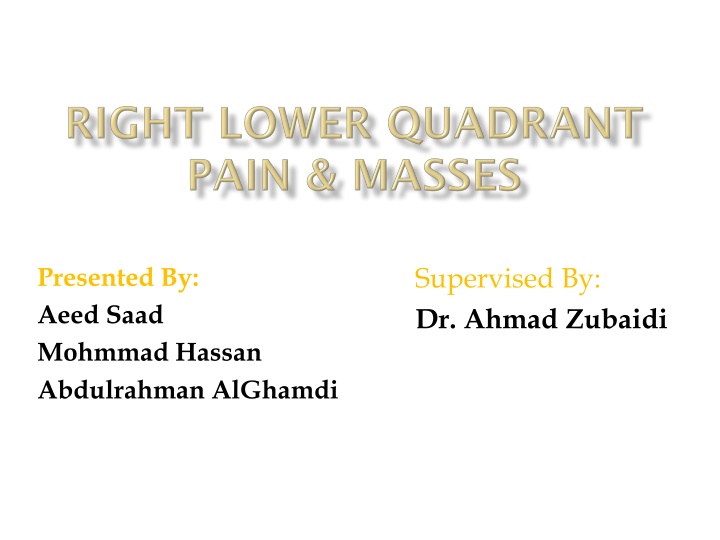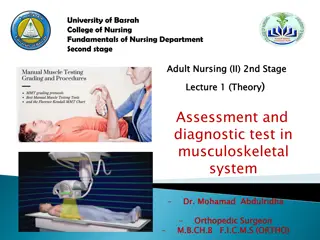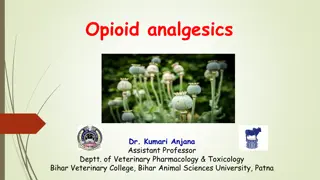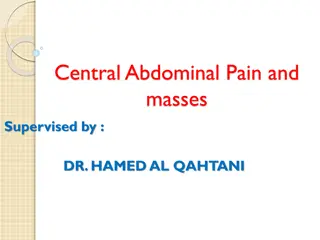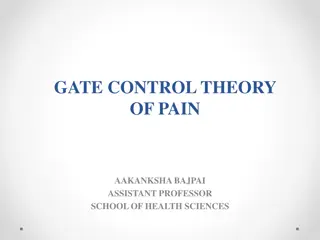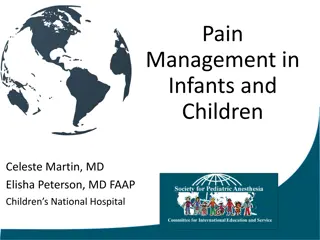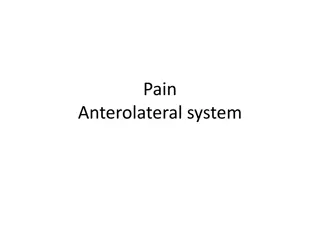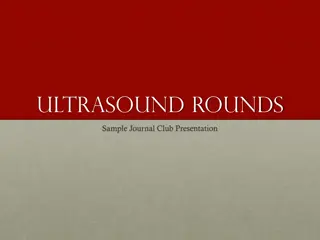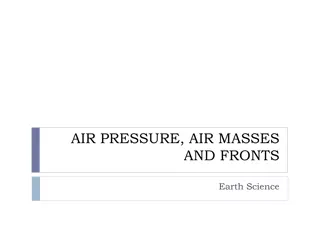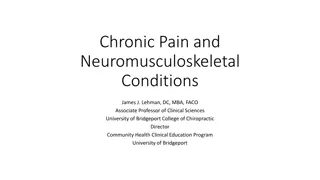RLQ Pain and Masses
The right lower quadrant (RLQ) extends from the median plane to the right of the patient and contains important organs such as the cecum, appendix, ascending colon, right ovary, and more. The most common presenting symptom is pain, accompanied by various associated symptoms. Diagnosis involves general and local examinations, lab tests, and radiological investigations. Common conditions leading to RLQ pain include appendicitis, Crohn's disease, tuberculsosis, and more. Epidemologically, appendicitis is a common surgical emergency with a risk of perforation increasing over time.
Download Presentation

Please find below an Image/Link to download the presentation.
The content on the website is provided AS IS for your information and personal use only. It may not be sold, licensed, or shared on other websites without obtaining consent from the author.If you encounter any issues during the download, it is possible that the publisher has removed the file from their server.
You are allowed to download the files provided on this website for personal or commercial use, subject to the condition that they are used lawfully. All files are the property of their respective owners.
The content on the website is provided AS IS for your information and personal use only. It may not be sold, licensed, or shared on other websites without obtaining consent from the author.
E N D
Presentation Transcript
Supervised By: Dr. Ahmad Zubaidi Presented By: Aeed Saad Mohmmad Hassan Abdulrahman AlGhamdi
Anatomy The RLQ extends from the median plane to the right of the patient, and from the umbilical plane to the right inguinal ligament. 22-5-2011 RLQ pain and masses
Impotant organs of the RLQ: Cecum Appendix Ascending Colon Right ovary and Fallopian tube Right ureter Mcburney s point 22-5-2011 RLQ pain and masses
The most common presenting symptom is pain. Pain: Site nature radiation onset - frequency aggravating and relieving factors severity associated symptoms Nausea, vomiting, and anorexia. Bowel habits: diarrhea constipations flatus - change in stool color Urinary symptoms. Gynecological symptoms. 22-5-2011 RLQ pain and masses
22-5-2011 RLQ pain and masses
General Examination Vital sign Local Examination Inspection Palpation Percussion Auscultation 1. 2. 3. 22-5-2011 RLQ pain and masses
Lab tests: CBC Arterial blood gases U&E LFT Urine dip stick Radiological invest.: abdominal x-ray Ultrasound CT scan MRI laprotomy 22-5-2011 RLQ pain and masses
Appendicitis Appendicular mass Crohn s disease Appendicular abscess Meckel s Diverticulum Tuberculosis Gyne dis. (ectopic Psoas abscess pregnancy, PID, Ovarian Urological differntial torsion) others malignancy 22-5-2011 RLQ pain and masses
Appendicitis 22-5-2011 RLQ pain and masses
Epidemiology: Appendicitis is one of the more common surgical emergencies, and it is one of the most common causes of abdominal pain. Appendicitis occurs in 7% of the US population, with an incidence of 1.1 cases per 1000 people per year. Risk of perforation: 25% in first 24 hrs. 50% by 36 hrs. 75% by 48 hrs. 22-5-2011 RLQ pain and masses
Etiology: Obstruction of the appendiceal lumen : Lymphoid hyperplasia secondary to inflammatory bowel disease (IBD) or infections (more common during childhood and in young adults). Fecal stasis and fecaliths (more common in elderly patients). Parasites (especially in Eastern countries). Foreign bodies and neoplasms. 22-5-2011 RLQ pain and masses
Pathophysiology : Obstriction >> continuous secretion of fluids and mucus from the mucosa and the stagnation of this material >> bacterial infection >> recruitment of white blood cells >> inflammation and pus formation . Persistent pressure appendiceal wall ischemia >> thrombosis of the appendicular artery and veins >> perforation and gangrene . obstruction >> venous >> outflow Increase intralumenal obstruction >> 22-5-2011 RLQ pain and masses
Clinical features: The most common symptom of appendicitis is abdominal pain. Typically, pain begins as periumbilical or epigastric migrating to the right lower quadrant (RLQ) of the abdomen. Later, a worsening progressive pain along with vomiting, nausea , and anorexia are described by the patient. Irritative voiding symptoms and hematuria or pyuria . 22-5-2011 RLQ pain and masses
Physical Examination Rebound tenderness in RLQ. 22-5-2011 RLQ pain and masses
EXAMINATION : INVESTIGATIONS: Low grade fever. Lab tests: Guarding, rebound Leukucytosis tenderness. Mild Pyuria (not severe>UTI) Signs: Radiology: X-ray: may show calcified fecalith Dunphy s sign Rovsing sign US: help rule out other pathologies. Obturator sign Psoas sign CT: Golden standard. 22-5-2011 RLQ pain and masses
Treatment: Preoperative IV fluids and antibiotics In nonperforated: Prompt appendectomy, 24 hours of antibiotics, discharge on next day. In perforated: IV fluid resuscitation, prompt appendectomy, drain the pus with 3-7 postoperative antibiotics. In appendiceal abcess: Percutaneous drainage and antibiotic adminstration, and elective appendectomy 6 weeks later 22-5-2011 RLQ pain and masses
If normal appendix is found upon exploration you should anyway. (ex: in crohn s) remove it Appendicitis and pregnancy: If appendicitis develops in a pregnant woman, an appendectomy is usually performed and should not harm the fetus. The risk of fetal death in the perioperative period appendectomy appendicitis is 3% to 5%. The risk of fetal death is 20% in perforated appendicitis. after an for early acute 22-5-2011 RLQ pain and masses
Crohn's disease is an inflammatory disease of the intestines that may affect any part of the gastrointestinal tract from mouth to anus, causing a wide variety of symptoms. 22-5-2011 RLQ pain and masses
Pathology **Macroscopically: Crohn's disease produces a cobblestone appearance,these can extend through all coats of the bowel wall. - **Microscopically: - may show mucosal inflammation, characterized by focal infiltration of neutrophils, a type of inflammatory cell, into the epithelium. And non-caseating granulomas in 50% of cases 22-5-2011 RLQ pain and masses
* Inflammatory: Fever. 1) Malaise. 2) Abdominal and Diarrhea usually the initial symptoms. (usually the diarrhea without blood). 3) Weight loss 4) Children and adolescents may have failure to thrive or have retarded growth. 5) Rectal bleeding is rare except in Chron's colitis. 6) 22-5-2011 RLQ pain and masses
*Fistulizing features: Para-enteric abscess formation often with a tender 1) abdominal mass Fistula formation(ileocolic, ileoileal,ileocutaneous) 2) Rarely free perforation with features of peritonitis. 3) 22-5-2011 RLQ pain and masses
*Stenosing features: 1- Colicky abdominal pain. 2- Weight loss due to poor food intake(food fear) 3- Palpable or visible distended small bowel loops. 22-5-2011 RLQ pain and masses
*Extraintestinal manifestations of crohn's disease: Clubbing & Erythema nodosum Pyoderma gangrenosum Oral ulcers Erythema nodosum Iritis Large joint arthritis Seronegative spondyloarthropathy(sacroiliitis, ankylosing spondylitis) Sclerosing cholangitis Renal stones 22-5-2011 RLQ pain and masses
LAB : *Blood: CBC,ESR,CRP,U&E,LFT,Blood culture. - Serum iron,B12,Red cell folate if anemia. *Laboratory Findings - Luekocytosis and increased sedimentation rate occur during the acute inflammatory phase. - Hypochromic, microcytic anemia due to chronic blood loss. - Occult blood in stool due to intestinal mucosal bleeding - Decreased serum albumin and total protein due to loss of protein from the intestinal mucosa and to impaired dietary intake. - Increased alkaline phosphatase, serum glutamic-oxaloacetic transminase (SGOT) (AST {aspartate aminotransferase}) or bilirubin due to associated liver disease. - Increased urine oxalate and calcium oxalate renalcalculi due to increased colonic absorption of dietary oxalate 22-5-2011 RLQ pain and masses
RADIOLOGY: The standard diagnostic investigation is barium follow- through(or small bowel enema). Double-contrast barium enema may be useful in assessing the extent of disease /delineate fistula formation. Active disease produces radiological evidence of thickening, luminal narrowing and separation of loops, and is often associated with ulceration, spike-like fissures and a cobblestone appearance 22-5-2011 RLQ pain and masses
Endoscopy - A colonoscopy is the best test for diagnosing Crohn s disease since it allows straight visualization of the colon and the terminal ileum, recognizing the pattern of the disease participation 22-5-2011 RLQ pain and masses
*Complications of Chrons Disease: Anal fistula/ abscess Stricture Perforation Toxic megacolon Obstruction - - - - - 22-5-2011 RLQ pain and masses
SURGICAL MANAGEMENT: Surgery does not cure Crohn's disease, but corrects an immediate problem that cannot be resolved using medication. Almost 75% of patients with crohn's disease require surgery at some stage. Surgery may have a role in the acute management of abscess or perforation, and in the chronic situation. Stricturoplasty Radical surgery is CONTRAINDICATED. Proctocolectomy and ileostomy. 22-5-2011 RLQ pain and masses
EMERGENCY Fulminant colitis or acute small bowel relapse unresponsive to medical management Acute bowel obstruction. Life threatening haemorrhage. Abcess or free perforation. Perianal abscess. 22-5-2011 RLQ pain and masses
ELECTIVE Chronic subacute obstruction due to fibrotic strictures, adhesions or refractory disease. Symptomatic disease unresponsive to or poorly controlled by medical management. Chronic relapsing disease on discontinuation of medical management and steroid dependency. Complications of medical management (e.g.osteoporosis). Concerns about long-term Immunosuppression, risk of malignancy and viral/atypical infections. 22-5-2011 RLQ pain and masses
Perianal sepsis and fistula Enterocutaneous fistula Onset of malignancy, including colorectal adenocarcinoma and small bowel lymphoma. 22-5-2011 RLQ pain and masses
Meckles Diverticulum 22-5-2011 RLQ pain and masses
A remnant of the vitellintestinal duct of the embryo The most common congenital abnormality of the gastrointestinal tract. The diverticulum is around 5 cm long . Arises from the antimesenteric border of the ileum some 50 cm from the ileocaecal valve. It is a true diverticulum. Usually symptomless, but may present with rectal bleeding or have the same clinical picture as appendicitis. 22-5-2011 RLQ pain and masses
Complications: small bowel volvulus, Rule of 2:occurs in 2% of intussusception and perforation. population, 2% symptomatic, 2 feet Treatment: asymptomatic adults away from the ileocecal valve, 2 surgery is not indicated. Wedge inches in length, 2 types of resection of divericulum in symptomatic mucosa(gastric and pancreatic), 2 patients or under 18 yrs of age times more common in male and 2 Asymptomatic diverticula found presentations bleeding and incidentally at laparotomy should be left obstruction. alone, unless the neck is narrow or Diagnosis:made by the aid of 99m nodularity suggests that the technetium scan. diverticulum contains abnormal mucosa 22-5-2011 RLQ pain and masses
Gynecological Differential 22-5-2011 RLQ pain and masses
a complication of pregnancy, in which the pregnancy implants outside the uterine cavity. Most commonly the fallopian tube. 22-5-2011 RLQ pain and masses
SYMPTOMS INVESTIGATIONS Pain in the lower abdomen. Vaginal bleeding, usually mild. Pregnancy test positive Urinary B-HCG test fast blood B-HCG accurate Ultrasound show a gestational sac in the ectopic location 22-5-2011 RLQ pain and masses
TREATMENT Medical Methotrexate Surgical : If hemorrhage has already occurred, surgical intervention may be necessary. However, whether to pursue surgical intervention is an often difficult decision in a stable patient with minimal evidence of blood clot on ultrasound. Surgeons use laparoscopy or laparotomy to gain access to the pelvis and can either incise the affected Fallopian and remove only the pregnancy (salpingostomy) or remove the affected tube with the pregnancy (salpingectomy). 22-5-2011 RLQ pain and masses
COMPLICATIONS Rupture internal bleeding shock Infertility in 10-15% of women 22-5-2011 RLQ pain and masses
Pelvic Inflammatory Disease 22-5-2011 RLQ pain and masses
It is acute salpingitis in one or both of the fallopian tubes, but it is often associated with infection of the surrounding tissue. Commonly in married women (15-45yrs) The most common organism is gonococcus and streptcoccus 22-5-2011 RLQ pain and masses
SYMPTOMS Purulent, yellow white vaginal discharge. Lower abdominal pain History of irregular menses and dymenorrhea. Fever Sweating and rigors 22-5-2011 RLQ pain and masses
EXAMINATION Flushed and feverish looking Tenderness and guarding Percussion and auscultation usually normal. Vaginal examination, discharge Bimanual palpation will cause pain and a mass will be present if there is an abscess 22-5-2011 RLQ pain and masses
INVESTUGATIONS: TREATMENT: CBC leucocytosis Blood culture Swab of vaginal discharge and send for culture Antibiotic therapy cefotoxin(2 g IV q 6hrs) and doxycycline (100 mg PO or IV q 12 hrs) 22-5-2011 RLQ pain and masses
Ovarian Torsion 22-5-2011 RLQ pain and masses
Changes in normal ovaries to congenital and developmental abnormalities or even a disease that affects the tube or ovary. Normal ovaries that experience spasms or changes in the blood vessels in the mesosalpinx can become twisted. Developmental abnormalities of the fallopian tube such as extremely longer-than-normal tubes. Diseases such as ovarian cysts or fibromas. Tumor of the ovary or tubes. Trauma 22-5-2011 RLQ pain and masses
SYMPTOMS EXAMINATION fever, tenderness, unilateral Sudden onset of severe adenxal mass may be lower abdominal pain, palpable upon pelvic exam. may radiate to the back Investigations: N & V B-HCG (-ve) - Ultrasound 60% in the right side - Diagnostic Laproscopy - 22-5-2011 RLQ pain and masses
MANAGEMENT: Surgical: Salpingo- oophorectomy untwist the pedicle perform cystectomy if the cause is ovarian cyst. stabilize the ovary The key to successful treatment is early diagnosis to prevent infarction of the ovary 22-5-2011 RLQ pain and masses
Malignancy 22-5-2011 RLQ pain and masses
